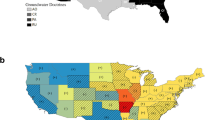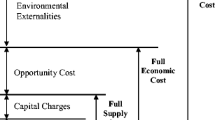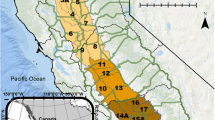Abstract
Price-based irrigation water-conservation policies are often designed as fixed per unit fees. In groundwater commons, however, this approach presupposes that irrigators assign the same value to each unit of water withdrawn, irrespective of the scarcity levels they individually face. This ignores spatial interdependencies in groundwater commons. In this paper, I examine the effect this possible tax structure misspecification has in measuring the performance of such Pigouvian taxes. I model the price of irrigation water as a non-constant marginal cost function dependent on the constant per unit fee and a variable cost-metric measure of scarcity, namely depth-to-water. Using a difference-in-difference econometric framework with irrigation data from San Luis Valley, results show that irrigators’ response to the constant marginal fee significantly depends on the scarcity levels individual irrigators face. More importantly, the results suggest that models that overlook the spatial element of scarcity would overestimate irrigators’ response to such pumping fee—which can misguide policy decisions.

Source: USGS Circular 1441

Source: Adapted from Pfeiffer and Lin (2012)

Source: Rio Grande Basin Implementation Plan, January 2022
Similar content being viewed by others
Data availability
Data may be made available upon reasonable request as it is publicly available from the Colorado’s Decision Support Systems (CDSS).
Notes
It is worth noting that the index for individual irrigator is dropped for simplicity since irrigators’ optimization problem is identical.
The terms farmer, irrigator and producer will be used interchangeably in this paper.
This assumption applies to the agricultural production in the San Luis Valley in Colorado, the study region of this paper. In the San Luis Valley, irrigators generally grow a specific crop on a parcel of land for a growing season. In other words, cultivated parcels of land are in effect crop-specific parcels; there is generally no mixed cropping on a given parcel in a given farming season. We can, therefore, argue that inputs are exclusively assigned to crop-specific cultivation activities and this in turn ensures that we are able to attribute each crop’s output to their unique input assignment.
The relationship is clearer by recognizing that from the total derivative of B(s, b), we have \(\frac{\hbox{d}B(\cdot )}{\hbox{d}b} = \frac{\partial B(\cdot )}{\partial s} \cdot \frac{\hbox{d}s}{\hbox{d}b} + \frac{\partial B(\cdot )}{\partial b}\).
A seventh sub-district was also formed, known as the Trinchera Groundwater Management Subdistrict, which is managed under the Trinchera Water Conservancy District (TWCD). The data for this study covers only RGWCD and not the TWCD.
Available online: https://www.colorado.gov/pacific/cdss/division-3-rio-grande.
The well decreed flow rate is the maximum allowable flow rate at which water can be pumped from a well.
The binary indicator, D is renamed \(Tax\_Treated\) in the results tables to be more informative.
These results are not presented in the paper but can be produced upon request.
References
Castle SL, Thomas BF, Reager JT, Rodell M, Swenson SC, Famiglietti JS (2014) Groundwater depletion during drought threatens future water security of the Colorado river basin. Geophys Res Lett 41(16):5904–5911
Dales JH (1968) Land, water, and ownership. Can J Econ/Revue canadienne d’Economique 1(4):791–804
Ficklin DL, Maxwell JT, Letsinger SL, Gholizadeh H (2015) A climatic deconstruction of recent drought trends in the united states. Environ Res Lett 10(4):044009
Frank MD, Beattie BR (1979) The economic value of irrigation water in the western united states: an application to ridge regression. Technical report, Texas Water Resources Institute
Gleick PH (2010) Roadmap for sustainable water resources in southwestern North America. Proc Natl Acad Sci 107(50):21300–21305
Guilfoos T, Khanna N, Peterson JM (2016) Efficiency of viable groundwater management policies. Land Econ 92(4):618–640
Hendricks NP, Peterson JM (2012) Fixed effects estimation of the intensive and extensive margins of irrigation water demand. J Agric Resour Econ 37:1–19
Hrozencik RA, Manning DT, Suter JF, Goemans C (2022) Impacts of block-rate energy pricing on groundwater demand in irrigated agriculture. Am J Agric Econ 104(1):404–427
Hrozencik RA, Manning DT, Suter JF, Goemans C, Bailey RT (2017) The heterogeneous impacts of groundwater management policies in the Republican River Basin of Colorado. Water Resour Res 53(12):10757–10778
Huang Q, Wang J, Rozelle S, Polasky S, Liu Y (2013) The effects of well management and the nature of the aquifer on groundwater resources. Am J Agric Econ 95(1):94–116
Koundouri P (2004) Current issues in the economics of groundwater resource management. J Econ Surv 18(5):703–740
Lago M, Mysiak J, Gómez CM, Delacámara G, Maziotis A (2015) Use of economic instruments in water policy. Springer, Berlin
Lau LJ et al (1976) Applications of profit functions. Center for Research in Economic Growth, Stanford University
Libecap GD (2011) Institutional path dependence in climate adaptation: Coman’s “some unsettled problems of irrigation’’. Am Econ Rev 101(1):64–80
Mieno T, Brozović N (2017) Price elasticity of groundwater demand: attenuation and amplification bias due to incomplete information. Am J Agric Econ 99(2):401–426
Moore MR, Negri DH (1992) A multicrop production model of irrigated agriculture, applied to water allocation policy of the bureau of reclamation. J Agric Resour Econ 17:29–43
Moore MR, Gollehon NR, Carey MB (1994) Multicrop production decisions in western irrigated agriculture: the role of water price. Am J Agric Econ 76(4):859–874
Mulligan KB, Brown C, Yang Y-CE, Ahlfeld DP (2014) Assessing groundwater policy with coupled economic-groundwater hydrologic modeling. Water Resour Res 50(3):2257–2275
Negri DH (1989) The common property aquifer as a differential game. Water Resour Res 25(1):9–15
Nieswiadomy M (1985) The demand for irrigation water in the high plains of Texas, 1957–80. Am J Agric Econ 67(3):619–626
Ogg CW, Gollehon NR (1989) Western irrigation response to pumping costs: a water demand analysis using climatic regions. Water Resour Res 25(5):767–773
Ostrom E (1990) Governing the commons: the evolution of institutions for collective action. Cambridge University Press, Cambridge
Pfeiffer L, Lin C-YC (2012) Groundwater pumping and spatial externalities in agriculture. J Environ Econ Manag 64(1):16–30
Provencher B, Burt O (1993) The externalities associated with the common property exploitation of groundwater. J Environ Econ Manag 24(2):139–158
Rogers DH, Alam M (2006) Comparing irrigation energy costs. Agricultural Experiment Station and Cooperative Extension Service, Kansas...
Rouhi Rad M, Manning DT, Suter JF, Goemans C (2021) Policy leakage or policy benefit? Spatial spillovers from conservation policies in common property resources. J Assoc Environ Resour Econ 8(5):923–953
Scanlon BR, Keese KE, Flint AL, Flint LE, Gaye CB, Edmunds WM, Simmers I (2006) Global synthesis of groundwater recharge in semiarid and arid regions. Hydrol Process Int J 20(15):3335–3370
Scheierling SM, Loomis JB, Young RA (2006) Irrigation water demand: a meta-analysis of price elasticities. Water Resour Res 42(1):W01411
Schoengold K, Sunding DL, Moreno G (2006) Price elasticity reconsidered: panel estimation of an agricultural water demand function. Water Resour Res 42(9):W09411
Schuerhoff M, Weikard H-P, Zetland D (2013) The life and death of Dutch groundwater tax. Water Policy 15(6):1064–1077
Shumway CR, Pope RD, Nash EK (1988) Allocatable fixed inputs and jointness in agricultural production: implications for economic modeling: reply. Am J Agric Econ 70(4):950–952
Smith SM (2018) Economic incentives and conservation: crowding-in social norms in a groundwater commons. J Environ Econ Manag 90:147–174
Smith SM, Andersson K, Cody KC, Cox M, Ficklin D (2017) Responding to a groundwater crisis: the effects of self-imposed economic incentives. J Assoc Environ Resour Econ 4(4):985–1023
Theis CV (1938) The significance and nature of the cone of depression in ground-water bodies. Econ Geol 33(8):889–902
Tsur Y, Dinar A (1997) The relative efficiency and implementation costs of alternative methods for pricing irrigation water. World Bank Econ Rev 11(2):243–262
Venot J-P, Molle F (2008) Groundwater depletion in the Jordan highlands: can pricing policies regulate irrigation water use? Water Resour Manag 22:1925–1941
Wang C, Segarra E (2011) The economics of commonly owned groundwater when user demand is perfectly inelastic. J Agric Resour Econ 36:95–120
Ward FA (2014) Economic impacts on irrigated agriculture of water conservation programs in drought. J Hydrol 508:114–127
Williams AP, Seager R, Abatzoglou JT, Cook BI, Smerdon JE, Cook ER (2015) Contribution of anthropogenic warming to California drought during 2012–2014. Geophys Res Lett 42(16):6819–6828
Wooldridge JM (2010) Econometric analysis of cross section and panel data. MIT Press, Cambridge
Yang H, Zhang X, Zehnder AJ (2003) Water scarcity, pricing mechanism and institutional reform in northern china irrigated agriculture. Agric Water Manag 61(2):143–161
Author information
Authors and Affiliations
Corresponding author
Ethics declarations
Conflict of interest
The author has no conflict of interest or funding sources to report.
Additional information
Publisher's Note
Springer Nature remains neutral with regard to jurisdictional claims in published maps and institutional affiliations.
About this article
Cite this article
Ekpe, G.K. Modeling and evaluating marginal pumping fees in groundwater commons: do varying scarcity levels matter?. Environ Econ Policy Stud (2023). https://doi.org/10.1007/s10018-023-00386-w
Received:
Accepted:
Published:
DOI: https://doi.org/10.1007/s10018-023-00386-w




